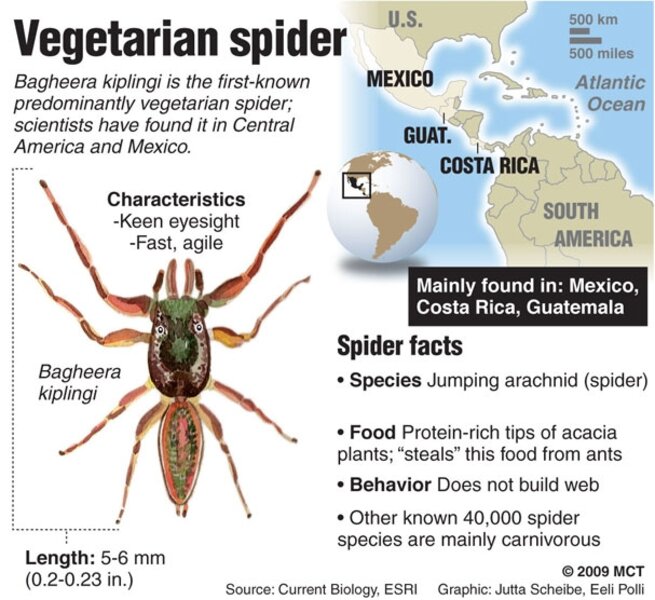Bagheera kiplingi: A vegetarian spider joins world's Jungle Book
Loading...
Spiders are the quintessential predators.
Their nearly 40,000 discovered species include eight-legged giants that feed on birds or hunt fish and tiny little demons like North America's Brown Recluse that are barely larger than a penny but have potent venom. There are the solitary ground-dwelling hunters like the Tarantula and others that look and smell just like ants - the better to safely move among them and eat them.
But all of them, until now, were believed to live only by taking life. That was before Bagheera kiplingi (aptly named for the friendly panther in Rudyard Kipling's Jungle Book) crept into view.
The recently described species of jumping spider, discovered by researchers from Villanova and Brandeis Universities, dines on the protein rich tips of acacias, the thorny shrubs found in much of Central America. What's more, it appears capable of eating food raw and digesting it (most spiders spit enzymes onto their prey that digests them externally into what, to spiders, is a tasty liquid).
But these thumb-sized spiders aren't mere leaf eaters. They're thieves.
The species of acacia, the salad bar favored by the Bagheera kiplingi, has protein-rich leaf tips and nutritious sap to reward its protectors. Protectors? Yes, the Pseudomyrmex ferruginea, are fearsome wasp-like ants with stingers to match. In return for food and shelter, the ants attack and drive off any insect that seeks to feed on the plant.
The Bagheera kiplingi has essentially evolved to steal from the mouths of the ants. These agile, inquisitive jumping spiders can leap up to 50 times their own body lengths (they do this hydraulically with a rapid increase in the blood pressure in their legs, which propels their legs down and the spiders through the air).
Competition for prey in the spider world is fierce. The Bagheera kiplingi's ancestors took the reflexes evolved for hunting and adapted into a creature that uses them for ant evasion. The truth is, this spider isn't a complete vegetarian – more of a flexitarian: it still snacks on the occasional ant attacker or ant larvae.
The "discovery" of Bagheera kiplingi's eating habits was first made in 2001 by entomologist Eric Olson. But the critter is only receiving media attention now after he and two co-authors published a full description of the spider in this week's edition of Current Biology and issued a press release.
Among the exciting aspects of the discovery is that this is not some rare species that could only be found by trekking deep into the Amazon. It's very common in arid parts of Mexico. In a paper written by Olson and co-researchers Christopher Meehan and Robert Curry in August of 2008 (titled "Exploitation of the Pseudomyrmex-Acacia mutualism by a predominantly vegetarian jumping spider," which probably explains why it didn't attract the attention of headline writers at the time) they report that in parts of Mexico the spiders are found on 55 percent of acacias.
The Bagheera kiplingi is cool. But in terms of arachnid news over the past decade, it's No. 2 on my list.
The top of the list is more gruesome (you've been warned). Plesiometa Argyra is a fairly common fly and mosquito catching spider in Costa Rica. Every day of its life it weaves a flimsy circular web to catch its prey - unless it gets stung by a Hymenoepimecis argyraphaga wasp. That's where this spider's life gets, well, very interesting.
The wasp sting briefly paralyzes the spider and eventually turns it into a zombie.
The parasitic wasp lays an egg on the belly of the spider. When the spider awakes, it carries on as if nothing happened for a few weeks, even as the attached larva hatches and begins to feed on its blood. Then, when the larva has had its fill and is ready to cocoon, it takes over the mind of the spider by injecting it with chemicals that circumvent its web-building routine.
Rather than the circular, disposable web the spider has made every day of its life, it weaves a thick, highly simplified cocoon platform, then placidly settles down in the middle of it to allow the wasp larva to finish eating it. His meal finished, the larva spins its cocoon, suspended on sticky spider silk far from marauding ants or other creatures that might want to eat it, waiting to emerge as a wasp and begin the dance again.





